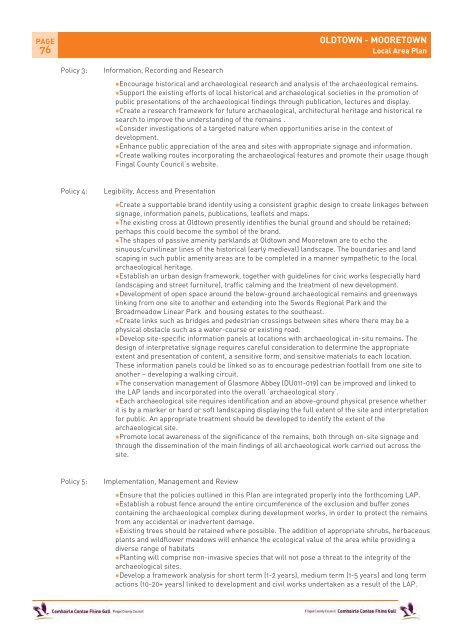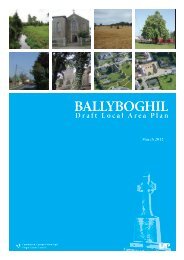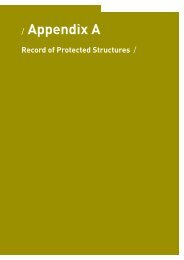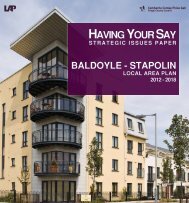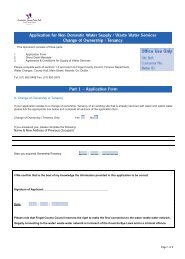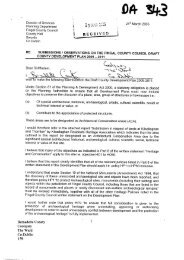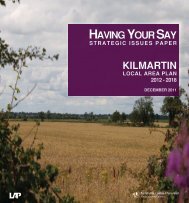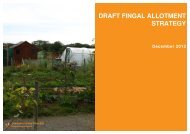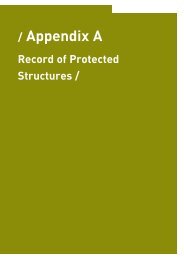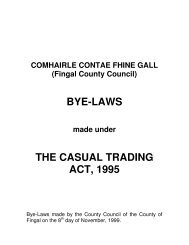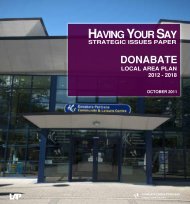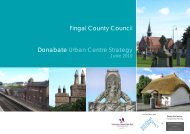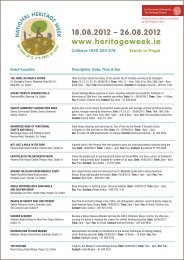Oldtown Mooretown - Text - Fingal County Council
Oldtown Mooretown - Text - Fingal County Council
Oldtown Mooretown - Text - Fingal County Council
You also want an ePaper? Increase the reach of your titles
YUMPU automatically turns print PDFs into web optimized ePapers that Google loves.
PAGE<br />
76<br />
Policy 3: Information, Recording and Research<br />
OLDTOWN - MOORETOWN<br />
Local Area Plan<br />
lEncourage historical and archaeological research and analysis of the archaeological remains.<br />
lSupport the existing efforts of local historical and archaeological societies in the promotion of<br />
public presentations of the archaeological findings through publication, lectures and display.<br />
lCreate a research framework for future archaeological, architectural heritage and historical re<br />
search to improve the understanding of the remains .<br />
lConsider investigations of a targeted nature when opportunities arise in the context of<br />
development.<br />
lEnhance public appreciation of the area and sites with appropriate signage and information.<br />
lCreate walking routes incorporating the archaeological features and promote their usage though<br />
<strong>Fingal</strong> <strong>County</strong> <strong>Council</strong>’s website.<br />
Policy 4: Legibility, Access and Presentation<br />
lCreate a supportable brand identity using a consistent graphic design to create linkages between<br />
signage, information panels, publications, leaflets and maps.<br />
lThe existing cross at <strong>Oldtown</strong> presently identifies the burial ground and should be retained;<br />
perhaps this could become the symbol of the brand.<br />
lThe shapes of passive amenity parklands at <strong>Oldtown</strong> and <strong>Mooretown</strong> are to echo the<br />
sinuous/curvilinear lines of the historical (early medieval) landscape. The boundaries and land<br />
scaping in such public amenity areas are to be completed in a manner sympathetic to the local<br />
archaeological heritage.<br />
lEstablish an urban design framework, together with guidelines for civic works (especially hard<br />
landscaping and street furniture), traffic calming and the treatment of new development.<br />
lDevelopment of open space around the below-ground archaeological remains and greenways<br />
linking from one site to another and extending into the Swords Regional Park and the<br />
Broadmeadow Linear Park and housing estates to the southeast.<br />
lCreate links such as bridges and pedestrian crossings between sites where there may be a<br />
physical obstacle such as a water-course or existing road.<br />
lDevelop site-specific information panels at locations with archaeological in-situ remains. The<br />
design of interpretative signage requires careful consideration to determine the appropriate<br />
extent and presentation of content, a sensitive form, and sensitive materials to each location.<br />
These information panels could be linked so as to encourage pedestrian footfall from one site to<br />
another – developing a walking circuit.<br />
lThe conservation management of Glasmore Abbey (DU011-019) can be improved and linked to<br />
the LAP lands and incorporated into the overall ‘archaeological story’.<br />
lEach archaeological site requires identification and an above-ground physical presence whether<br />
it is by a marker or hard or soft landscaping displaying the full extent of the site and interpretation<br />
for public. An appropriate treatment should be developed to identify the extent of the<br />
archaeological site.<br />
lPromote local awareness of the significance of the remains, both through on-site signage and<br />
through the dissemination of the main findings of all archaeological work carried out across the<br />
site.<br />
Policy 5: Implementation, Management and Review<br />
lEnsure that the policies outlined in this Plan are integrated properly into the forthcoming LAP.<br />
lEstablish a robust fence around the entire circumference of the exclusion and buffer zones<br />
containing the archaeological complex during development works, in order to protect the remains<br />
from any accidental or inadvertent damage.<br />
lExisting trees should be retained where possible. The addition of appropriate shrubs, herbaceous<br />
plants and wildflower meadows will enhance the ecological value of the area while providing a<br />
diverse range of habitats<br />
lPlanting will comprise non-invasive species that will not pose a threat to the integrity of the<br />
archaeological sites.<br />
lDevelop a framework analysis for short term (1-2 years), medium term (1-5 years) and long term<br />
actions (10-20+ years) linked to development and civil works undertaken as a result of the LAP.


